
Andhra Pradesh is a state in the southern coastal region of India. It is the seventh-largest state with an area of 162,970 km2 (62,920 sq mi) and the tenth-most populous state with 49,577,103 inhabitants. It shares borders with Chhattisgarh, Odisha, Karnataka, Tamil Nadu, Telangana and the Bay of Bengal. It has the second-longest coastline in India at about 974 km (605 mi). After existence as Andhra State and unified Andhra Pradesh, the state took its present form on 2 June 2014, when the new state of Telangana was formed through bifurcation. Amaravati is the capital of the state, with the largest city being Visakhapatnam. Water sharing disputes and asset division with Telangana are not yet resolved. Telugu, one of the classical languages of India used by the majority of people, is the first official language.
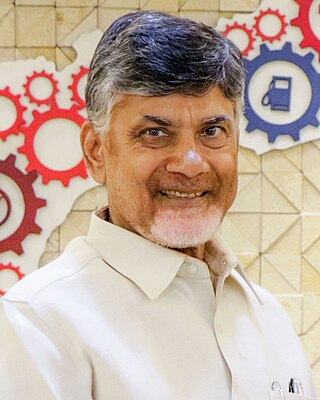
Nara Chandrababu Naidu, also known as Chandrababu Naidu or CBN, is an Indian politician, statesman and the current leader of the opposition in the Andhra Pradesh Legislative Assembly. He also served as Chief Minister from 1995 to 2004 and as opposition leader from 2004 to 2014 of Andhra Pradesh. He has been the national president of the Telugu Desam Party (TDP) since 2015.

The Telugu Desam Party is an Indian regional political party with great influence in the states of Andhra Pradesh and Telangana. It was founded by the former chief minister of Andhra Pradesh N. T. Rama Rao (N.T.R.) on 29 March 1982 and has focused on supporting Telugu speakers. The party has won a five-time majority in the Andhra Pradesh Legislative Assembly and has emerged as the most successful political outfit in the state's history. It is currently the main opposition party in the Andhra Pradesh Legislative Assembly.

Telangana is a state in India situated in the southern part of the Indian peninsula on the high Deccan Plateau. It is the eleventh-largest state and the twelfth-most populated state in India as per the 2011 census. On 2 June 2014, the area was separated from the northwestern part of United Andhra Pradesh as the newly formed state of Telangana, with Hyderabad as its capital.

Rayalaseema is a geographic region in the Indian state of Andhra Pradesh. It comprises four southern districts of the State, from prior to the districts reorganisation in 2022, namely Kurnool, Anantapur, YSR, and Chittoor. Four new districts were created from these, namely Sri Sathya Sai, Nandyal, Annamayya, and Tirupati. As of 2011 census of India, the western four districts of the region had a population of 15,184,908 and cover an area of 77,424 km2 (29,894 sq mi).
The Politics of Andhra Pradesh take place in the context of a bicameral parliamentary system within the Constitutional framework of India. The main parties in the state are the YSR Congress Party, Telugu Desam Party and Jana Sena Party. Other parties that have small presence in the state include the Indian National Congress, Bharatiya Janata Party and Left parties.
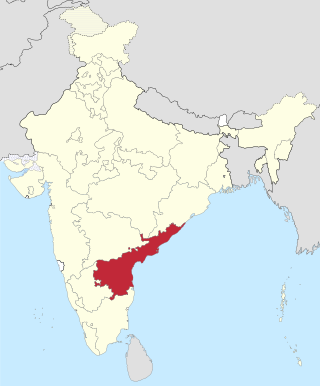
Andhra State was a state in India created in 1953 from the Telugu-speaking northern districts of Madras State. The state was made up of this two distinct cultural regions – Rayalaseema and Coastal Andhra. Andhra State did not include all Telugu-speaking areas, as it excluded some in Hyderabad State. Under the State Reorganisation Act of 1956, Andhra State was merged with the Telugu-speaking regions of Hyderabad State to form Andhra Pradesh.

North Andhra or Uttara Andhra, also known as Kalinga Andhra, is a geographic region in the Indian state of Andhra Pradesh. It is between the Eastern Ghats and the coast of the Bay of Bengal. It comprises six northern districts of the state, Srikakulam, Parvathipuram Manyam, Vizianagaram, Visakhapatnam, Alluri Sitharama Raju and Anakapalli. As of 2011 census of India, the region with six districts has a population of 9,338,177.

The recorded history of Andhra Pradesh, one of the 28 states of 21st-century India, begins in the Vedic period. It is mentioned in Sanskrit epics such as the Aitareya Brahmana. Its sixth-century BCE incarnation Assaka lay between the Godavari and Krishna Rivers, one of sixteen mahajanapadas. The Satavahanas succeeded them, built Amaravati, and reached a zenith under Gautamiputra Satakarni.
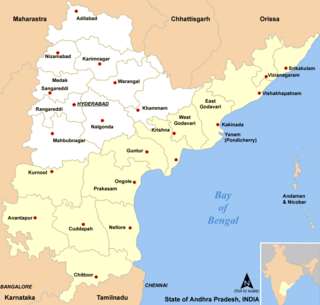
The Telangana movement refers to a movement for the creation of a separate state, Telangana, from the pre-existing state of Andhra Pradesh in India. The new state corresponds to the Telugu-speaking portions of the erstwhile princely state of Hyderabad, which were merged with Andhra Pradesh in 1956, leading to the Mulki Agitations.

Samaikya Andhra Movement was a movement organized to keep the Indian state of Andhra Pradesh united, and to prevent the division of the state - separating the Telangana districts of the state into a separate Telangana state. The movement was supported by government employees, advocates in Coastal Andhra & Rayalaseema regions along with students from 14 universities, various occupational, caste & religious groups of Coastal Andhra & Rayalaseema regions. The last set of protests were triggered after the Congress Working Committee decision to divide the state came to an end after President of India gave nod to Telangana Bill which would make the latter to come into existence from 2 June 2014.

The Yuvajana Sramika Rythu Congress Party is an Indian regional political party based in the state of Andhra Pradesh. Its president, Y. S. Jagan Mohan Reddy, serves as the state's chief minister. It currently has 17 seats in the Lok Sabha.
The Andhra Pradesh Reorganisation Act of 2014, commonly known as the Telangana Act, is an Act of Indian Parliament that split the state of Andhra Pradesh into Telangana and the residuary Andhra Pradesh state, as an outcome of the Telangana movement. The Act defined the boundaries of the two states, determined how the assets and liabilities were to be divided, and laid out the status of Hyderabad as the permanent capital of new Telangana state and temporary capital of the Andhra Pradesh state.
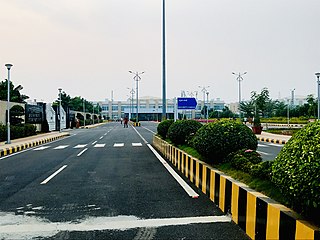
Amaravati is the greenfield capital of the Indian state of Andhra Pradesh. It is situated at the heart of the state, on the right bank of the river Krishna in Guntur district. It is near to Dharanikota, the ancient city site nearby, that served as the capital of Satavahana dynasty more than 2,200 years ago.
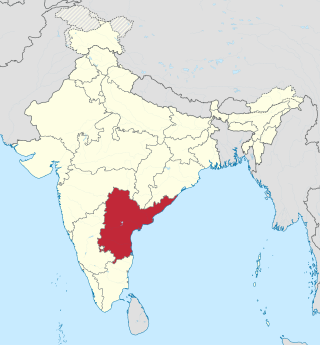
Andhra Pradesh, retrospectively referred to as United Andhra Pradesh, Undivided Andhra Pradesh or Ummadi Andhra Pradesh, was a state in India formed by States Reorganisation Act, 1956 with Hyderabad as its capital and was reorganised by Andhra Pradesh Reorganisation Act, 2014. The state was made up of three distinct cultural regions of Telangana, Rayalaseema, and Coastal Andhra. Before the 1956 reorganisation, Telangana had been part of Hyderabad State ruled by Nizam of Hyderabad, whereas Rayalaseema and Coastal Andhra had been part of Andhra State, formerly a part of Madras Presidency ruled by British India.
The 2019–2024 Amaravati protests, simply known as Amaravati protests, are ongoing demonstrations in the Indian state of Andhra Pradesh triggered by the idea of changing the one capital of Amaravati already identified and developed partially, to three capitals of Amaravati, Visakhapatnam and Kurnool by the Government of Andhra Pradesh. This led to concerns that the decision would create chaos and insecurity for farmers who gave their fertile agricultural lands to the government in 29 villages of Guntur district. The protests began in Mandadam, Thullur, Uddandarayunipalem on 18 December 2019. In a few days, the protests spread across Andhra Pradesh Capital Region, in Andhra Pradesh. On 17 December 2020, series of events were done to mark the protests' anniversary.
The Andhra Pradesh Decentralisation and Inclusive Development of All Regions Act, 2020 is an act of Andhra Pradesh Legislature aimed at the decentralisation of governance in the Indian state of Andhra Pradesh. The bill was proposed by the Government of Andhra Pradesh to establish three capitals at different places in the state namely Visakhapatnam, Amaravati, and Kurnool, which will serve as executive, legislative and judicial capitals respectively.
















